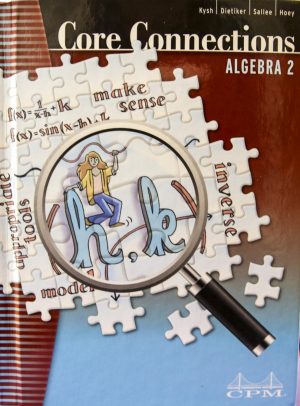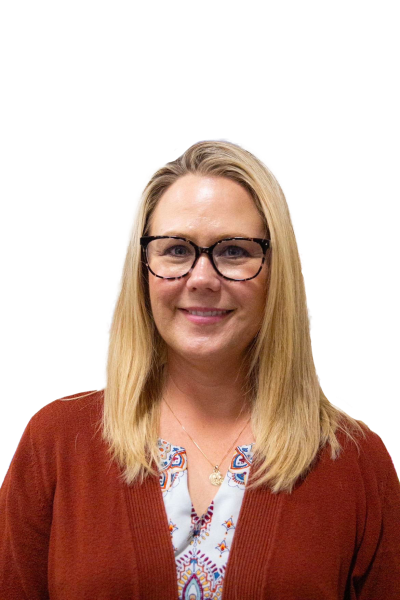Aftermath
PHS math teachers revise approach to controversial math curriculum following concerns
In a traditional math class, a student sits at a single-student desk and watches as a teacher solves example problems on a board.

One of the textbooks math teachers started using this year.
For years, this was the only instructional method PHS math students knew.
But research from the Kansas State Department of Education (KSDE) prompted PHS math teachers to reevaluate their method.
“A focused, coherent progression of mathematics learning, with an emphasis on conceptual understanding and fluency, should be the norm in every mathematics classroom in Kansas,” said KSDE’s White Paper on Fluency.
Taking KSDE’s advice, the math teachers implemented a teaching method in which students guide themselves through lessons in small groups while their teacher walks around a classroom and facilitates. They also adopted College Preparatory Math (CPM), a new set of textbooks in addition to the new delivery system.
The method is based on eight principles from the National Council for Teachers of Mathematics (NCTM). According to the principles, the teachers are facilitating “meaningful mathematical discourse,” “supporting productive struggle,” posing “purposeful questions” and implementing “tasks that promote reasoning.”
“[Students] don’t have to sit and be told everything. But together, they can discuss and figure things out,” math teacher Rhonda Willis said. “And they’re so proud of that.”
For some students, the change was a step in the right direction.
“It teaches you how to think more intelligently instead of just regurgitating what the teacher is saying on the board every day,” freshman Emily McGown said. “You start to become more independent and you learn teamwork skills.”
For others, the decrease in traditional instruction was a difficult adaptation.
“I was just worried because I felt like my questions weren’t being answered,” sophomore Carmen Kent said. “If I didn’t understand the concept, we moved on rather than make it so that we had a full understanding.”
After listening to parent and student concerns such as Kent’s, math teachers modified their delivery of CPM.
“There was a lot of pressure at the beginning of the semester to do it just like CPM does,” math teacher Kristi Neef said. “It took me about half a semester to realize that I can’t do that. I have to make it my own.”
First, the teachers changed their approach to group learning.
Willis’s student groups, for example, now reconvene as a full class either for direct instruction or follow-up at the end of class rather than having Willis facilitate the entire time.
“As educators, the hope is that we could question [students] in a perfect way that would pull information out of them,” Willis said. “If we come together and students haven’t discovered or pulled out the information, then we might need to teach it to them in a different way.”
Similarly, if algebra I teacher Trevor Elliott notices certain topics do not “sink in” as he expects them to, he adjusts his teaching style for the rest of his classes and spends part of the next day reteaching the original class.
“Adjustments are constantly made based on the needs of the students in the classroom,” Elliott said.
Math teacher Matt Butler, on the other hand, has moved closer toward a traditional system.
“It’s more of a partner-type learning instead of a big-group learning,” Butler said. “As far as algebra, we’ve kind of steered away from [group learning] for now because we started this semester off by going back and reviewing.”
Freshman Rose Scott, who is in Butler’s algebra I class, said this revision has helped her.
“Without [teacher] guidance, those students are never going to improve,” Scott said. “Now, it’s more focused on the person who actually went to college and actually went through the school is the one teaching the kids instead of them being based on each other.”
Butler said he will eventually incorporate group learning again.
“I haven’t gotten into a consistent pattern of groups of four, but it is definitely something that I will be getting back into at some point,” Butler said.
Some students, however, said they prefer group learning over the traditional method.
“It’s easier for me to sit in a group of four and ask my peers for help instead of a teacher,” junior Shyanne Puffinbarger said. “Instead of getting up the courage to ask a teacher, it is so much easier for me to ask a fellow student instead.”
Teachers also revised their homework policies.
Last semester, teachers did not grade homework assignments.
“It was like there was no goal for doing your homework or even trying,” sophomore Alora Spencer said.
This semester, teachers began grading homework.
“It’s a bigger motivator for students to get their homework done,” Willis said. “The students who aren’t completing the homework, their grades are looking worse.”
Neef said the homework assignments average at around five word problems a night. Many people who did not succeed with CPM did not do the homework, she said.
“I hate that some kids didn’t do well, but when you don’t do 11 assignments out of the 11 assignments that I ask you to practice, there’s no way you’re going to be successful,” Neef said.
Sophomore Emily Tarter, on the other hand, said she often gives up on her homework because she has difficulty understanding the concepts.
“I slack off sometimes because I’m human,” Tarter said. “I do that because I don’t know what I’m doing even if I read chapters and go back in the book.”
According to Willis, many students who failed or struggled with a CPM math class did not have a strong skill set in algebra I.
“If your skills were low in algebra I, then I think you can’t do any of the homework,” Willis said. “It shocked students. It’s like putting a frog in a hot frying pan.”
Thus, to improve student success, administration created math foundations — a class for students who failed or struggled in their math classes, where students learn the foundations of algebra I. Rashell Yockey and Elliott teach the classes.
“We got a system and when the system changed, it created [problems],” principal Phil Bressler said. “That’s normal: it’s part of the change process. This is our response to kids who are struggling.”
Based on MAP scores, students who had the skills to pass their math class but received a failing grade because they did not put forth the effort can enroll in a credit recovery class, where they retake the class in an online setting.
“We separated kids who failed between kids who won’t do the work and kids who can’t do the work,” Bressler said. “They don’t have the requisite skills to be successful.”
Since last semester, students and parents have seen improvements.
Gina Pinamonti said that at the beginning of the last semester, her daughters would stay awake nightly attempting to finish their homework. Now, things have changed.
“They haven’t brought me any concerns,” Pinamonti said. “They’re just plugging away and studying when it’s appropriate. The girls seem happy, so I’m happy.”
Kent also said she is happy with the way things are going.
“This semester has been a lot better for me. There’s been a lot more adaptations to realizing that kids need more than just to be set on their own,” Kent said.
The math department will continue using CPM and these teaching methods next year.
“Even with all of the negatives and the failures that we had last semester, there’s a lot of positives. We need to keep it,” Neef said. “I can’t go back to what I know isn’t right.”
Your donation will support the student journalists of Pittsburg High School - KS. Your contribution will allow us to purchase equipment and cover our annual website hosting costs.






